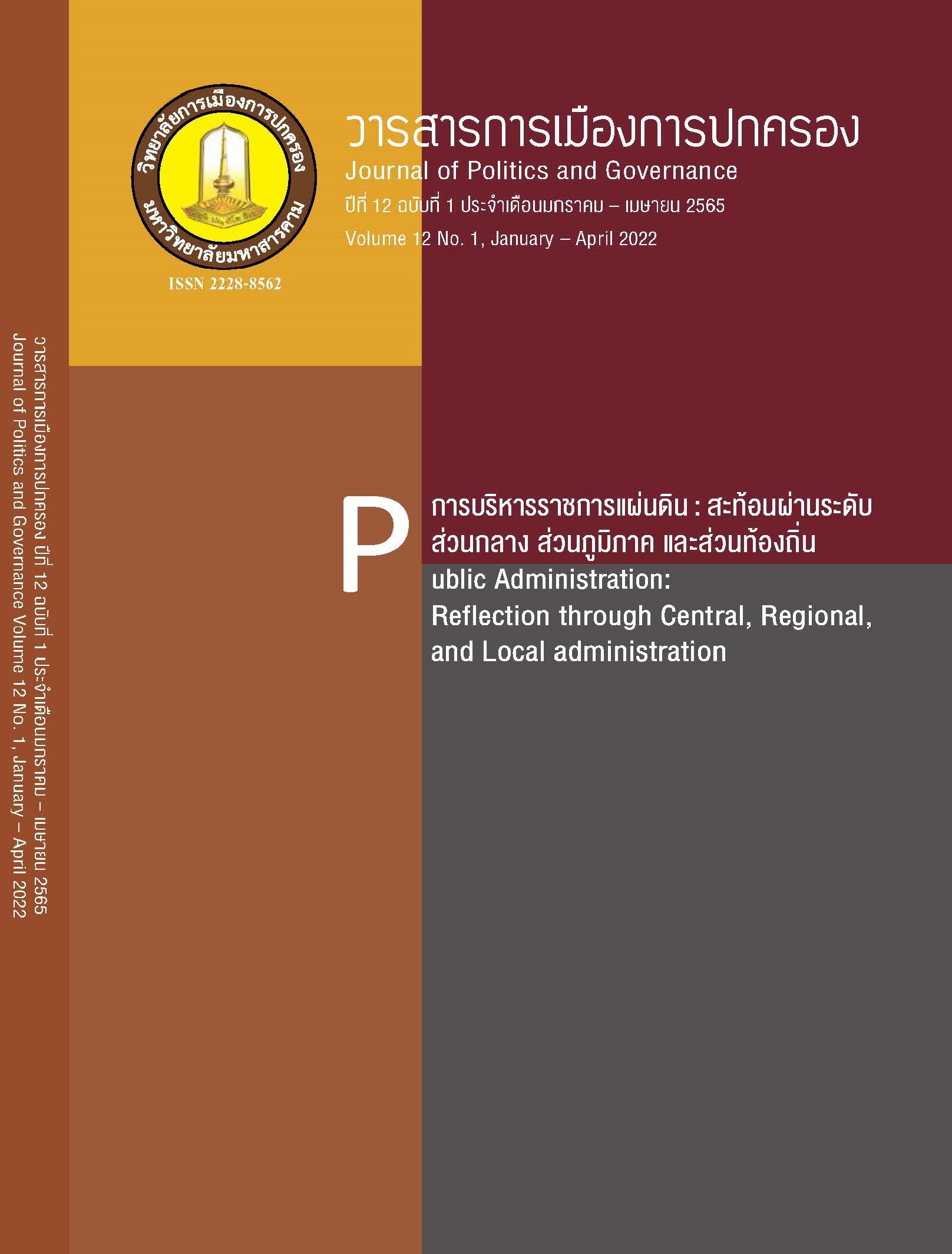The Investment Model and Guidelines that Suitable for Social Security fund in Thailand
Main Article Content
Abstract
This research studied the suitability of investment models for social security funds in Thailand and also the most appropriate approaches for social security funds to achieve effective investment development. A qualitative methodology was adopted based on a Delphi Technique with three rounds of questioning to reach a consensus. In the first round, in-depth interviews were conducted with 17 key informants, including 10 interviewees from the Financial Management Department of the Social Security Office and 7 interviewees responsible for investment of the Thai Social Security Fund. Findings of the first round of interviews were summarized. In the second and third rounds of the Delphi technique analysis, questions were tested for P-Value statistics and confirmed by the quantitative results from 71 experts. The Kruskal-Wallis test by one-way ANOVA was over 0.05, indicating that all questions were confirmed with the same results and could be used in group discussions in the next step. This research adapted the issues from the third Delphi analysis to conduct a group discussion with 8 executives and investment experts from the Social Security Fund. Results showed that suitable investment models for social security funds in Thailand can be divided into 6 areas as follows: 1) vision, 2) revenue storage consisting of 4 sub-points, 3) payment of benefits, 4) investment management consisting of 6 sub-points, 5) risk management consisting of 7 sub-points, and 6) future investment consisting of 2 sub-points. Approaches for development of the effective investment model of the Thai Social Security Fund can be divided into 8 areas as follows: 1) investment management consisting of 7 sub-points, 2) evaluation and inspection consisting of 2 sub-points, 3) information technology consisting of 2 sub-points, 4) legal and regulations consisting of 4 sub-points, 5) risk management consisting of 7 sub-points, 6) human resources management consisting of 5 sub-points, 7) financial accounting system consisting of 5 sub-points, and 8) procurement system consisting of 4 sub-points. Investment options should increase the proportion of risk-weighted assets to 11%, while the higher proportion of stable assets should be reduced by 11%.
Article Details
References
กลุ่มงานสถิติและคณิตศาสตร์ประกันภัย. (2560). สถิติงานประกันสังคม 2559. กรุงเทพฯ: กองวิจัยและพัฒนา สำนักงานประกันสังคม.
ขนิษฐา ดวงผุนมาตย์. (2556). การวิคราะห์อัตราผลตอบแทนและความเสี่ยงของหลักทรัพย์ ในกลุ่มธุรกิจเกษตรโดยใช้แบบจำลอง CAPM. (รายงานการศึกษาอิสระปริญญาเศรษฐศาสตรมหาบัณฑิต). สาขาเศรษฐศาสต์ธุรกิจ คณะวิทยาการจัดการ, มหาวิทยาลัยขอนแก่น.
ชญานิศฐ์ รักแจ้ง. (2554). การให้บริการของสำนักงานประกันสังคมตามหลักสังคหวัตถุ 4 ตามทัศนะของผู้ประกันตนเขตกรุงเทพมหานคร. (วิทยานิพนธ์พุทธศาสตรมหาบัณฑิต). สาขาวิชารัฐประศาสนศาสตร์, บัณฑิตวิทยาลัย, มหาวิทยาลัยมหาจุฬาลงกรณ์ราชวิทยาลัย.
ชุรีพร สีสนิท. (2553). ปัจจัยที่ส่งผลต่อแนวโน้มการตัดสินใจลงทุนในกองทุนรวมหุ้นระยะยาวของลูกค้าบริษัทหลักทรัพย์จัดการกองทุนรวมแห่งหนึ่ง ในเขตกรุงเทพมหานคร. (สารนิพนธ์ปริญญาบริหารธุรกิจมหาบัณฑิต). สาขาวิชาการจัดการ บัณฑิตวิทยาลัย, มหาวิทยาลัยศรีนครินทรวิโรฒ.
ฐาปนา ฉิ่นไพศาล. (2555). การจัดการการเงิน. กรุงเทพมหานคร: ยงพลเทรดดิ้ง.
ณัฏฐพงศ์ ทองภักดี. (2558). เศรษฐศาสตร์สาธารณะ. กรุงเทพฯ: ศูนย์ศึกษาเศรษฐกิจพอเพียง สถาบันบัณฑิตพัฒนบริหารศาสตร์.
ดิเรก ปัทมสิริวัฒน์. (2553). การคลังท้องถิ่น: รวมบทความวิจัยเพื่อเพิ่มพลังให้ท้องถิ่น. กรุงเทพมหานคร: พี เอ ลีฟวิ่ง.
ทิชากร. จักรคาม. (2554). การวิเคราะห์อัตราผลตอบแทนและความเสี่ยงของการลงทุนในตลาดหลักทรัพย์แห่งประเทศไทยหมวดพัฒนาอสังหาริมทรัพย์. (การศึกษาค้นคว้าอิสระบริหารธุรกิจมหาบัณฑิต). สาขาการเงิน, มหาวิทยาลัยหอการค้าไทย.
ธนภร ชลศิริวานิช และกฤช จรินโท. (2555). ความรู้และความเข้าใจในการเลือกลงทุนของนักลงทุนทั่วไปใน ประเทศไทย. RMUTT Global Business and Economics Review, 7(2), 53-64.
ธนาคารแห่งประเทศไทย. (2563). มิติใหม่ลงทุนนอกด้วยตนเอง. กรุงเทพฯ: ธนาคารแห่งประเทศไทย.
นรเศรษฐ์ ศรีธานี. (2551). การวิเคราะห์ความเสี่ยงและผลตอบแทนจากการลงทุนในหลักทรัพย์ ในตลาดหลักทรัพย์แห่งประเทศไทย ด้วยเทคนิค Value at Risk (VaR). การประชุมวิชาการครั้งที่ 6. มหาวิทยาลัยเกษตรศาสตร์ วิทยาเขตกำแพงแสน.
นุสรา วีระสุนทรและกิตติพันธ์ คงสวัสดิ์เกียรติ. (2556). การศึกษาเปรียบเทียบความเสี่ยงและอัตราผลตอบแทนของหลักทรัพย์หมวดประกันภัยและประกันชีวิตโดยใช้แบบจําลอง CAPM. วารสารการเงิน การลงทุน การตลาด และการบริหารธุรกิจ, 3(1), 36-53.
พิชญาภรณ์ กุลเศรษฐ. (2555). มาตรการทางกฎหมายประกันสังคมในการคุ้มครองแรงงาน ศึกษาเฉพาะภาคเกษตรกรรม. (วิทยานิพนิติศาสตร์มหาบัญฑิต). สาขานิติศาสตร์ คณะนิติศาสตร์, มหาวิทยาลัยธุรกิจบัณฑิตย์.
วรวรรณ ชาญด้วยวิทย์และคณะ. (2551). หลักประกันด้านรายได้สำหรับผู้สูงอายุไทย. กรุงเทพมหานคร:สถาบันวิจัยเพื่อการพัฒนาประเทศไทย.
วันรักษ์ มิ่งมณีนาคิน. (2553). เศรษฐศาสตร์เบื้องต้น: เศรษฐศาสตร์สำหรับบุคคลทั่วไป. กรุงเทพมหานคร: สำนักพิมพ์มหาวิทยาลัยธรรมศาสตร์.
วิมล ชาตะมีนา และคณะ. (2551). การศึกษาวินัยทางการคลังของประเทศไทย. (อดีตสู่ปัจจุบัน) และแนวทางในการเสริมสร้างวินัยทางการคลงตามหลักสากล. กรุงเทพมหานคร: สำนักงานเศรษฐกิจการคลัง.
สมชัย จิตสุชนและคณะ. (2554). สู่ระบบสวัสดิการสังคมถ้วนหน้าภายในปี พ.ศ. 2560. กรุงเทพมหานคร: สถาบันวิจัยเพื่อการพัฒนาประเทศไทย.
สำนักงานประกันสังคม. (2562). พระราชบัญญัติ. สืบค้นจาก https://www.sso.go.th/wpr/main/ law/พระราชบัญญัติ_category_list-label_1_106_0
สำนักงานประกันสังคม. (2563). ส่องเงินกองทุนประกันสังคม 2 ล้านล้านบาท ใช้ทำอะไรบ้าง? เงินหายจริงไหม?. สืบค้นจาก https://www.sso.go.th/wpr/assets/upload/files_storage/sso_th/900b06662ae9768005732f7cabe3ba95.pdf
สิริกาญจน์ ศิโรจน์นวากุล. (2557). ความรู้เกี่ยวกับสิทธิประโยชน์ทดแทนของผู้ประกันตนที่ทำงานในสถานประกอบการนิคมอมตะนครจังหวัดชลบุรี. (วิทยานิพนธ์นี้รัฐประศาสนศาสตรมหาบัณฑิต). สาขาวิชาการบริหารทั่วไป, วิทยาลัยการบริหารรัฐกิจ, มหาวิทยาลัยบูรพา.
อัจฉรีย์ งามพร้อมสกุลและ สมาน งามสนิท. (2559). การบริหารการประกันสังคมของสํานักงานประกันสังคมตามปรัชญาของเศรษฐกิจพอเพียง. วารสารวิชาการมหาวิทยาลัยอีสเทิร์นเอเชีย ฉบับสังคมศาสตร์และมนุษยศาสตร์, 6(2), 341-352.
Amadeo, K. (2020). Fiscal Policy Types, Objectives, and Tools. Retrieved from https://www.thebalance.com/what-is-fiscal-policy-types-objectives-and-tools-3305844
Anderson, J. E. (1975). Public policy making. New York: Holt, Winson & Rinehart.
Carhart, M. M. (1997). On Persistence in Mutual Fund Performance. The Journal of Finance, 52(1), 57 – 82.
Chen, J. (2019). Investment. Retrieved from https://www.investopedia.com/terms/i/ investment.asp
Duermyer, R. (2019). What Is Return on Investment (ROI)?. Retrieved from https://www.thebalancesmb.com/roi-return-on-investment-1794432
Dye, T. R. (1992). Understanding public policy. Englewood Cliffs, NJ: Prentice Hall.
Fama, E. F., and French, K. R. (1993). Common risk factors in the returns on stocks and bonds. Journal of Financial Economics, 33, 3 – 56.
Felkins, P. K. (2002). Communities and social capital. In Community at Work: Creating and celebrating community in organizational life. New Jersey: Hampton Press.
Friedrich, C. J. (1963). Education manpower and economic growth: Strategies of human resource development. New York: McGraw-Hill.
Grimsley, S. (2020). What is an Investment? - Definition & Overview. Retrieved from https://study.com/academy/lesson/what-is-an-investment-definition-lesson-quiz.html
Jegadeesh, N. & Titman, S. (1993). Returns to buying winners and selling losers: Implications for stock market efficiency. Journal of Finance, 48(5), 65 - 91.
Kappel, M. (2016). What is return on investment (ROI)? – Definition and Meaning. Retrieved from https://www.patriotsoftware.com/blog/accounting/what-is-roi/
Ledwith, S. & Munakamwe, J. (2015). Gender, union leadership and collective bargaining: Brazil and South Africa. The Economic and Labour Relations Review, 26(3), 411 - 429.
Kramer, L. (2019). What Is Fiscal Policy?. Retrieved from https://www.investopedia. com/insights/what-is-fiscal-policy/
Luxsanakulton, N. (2018). Investment Risk. Retrieved from https://www. coolontop.com/investment-risk/
Moneywecan. (2020). การลงทุน. Retrieved from https://www.moneywecan.com/investment-knowledge/
Pearce, J. M. (2015). Return on Investment for Open Source Hardware Development. Science and Public Policy, 43(2), 192 - 195.
Reilly, F. K. (1989). Investment analysis and portfolio management. 3rd ed., Fort Worth: Dry- den Press.
Sharkansky, I. (1970). Public policy in political science. Chicago: Markham.
Weil, N. D. (2020). Fiscal Policy. Retrieved from https://www.econlib.org/library/Enc/FiscalPolicy.html


